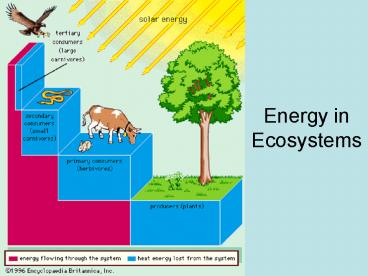Energy in Ecosystems - PowerPoint PPT Presentation
Title:
Energy in Ecosystems
Description:
Energy/Ecological Pyramids Another way to look at trophic levels. a diagram showing the relative amounts of energy/biomass in the different trophic levels. – PowerPoint PPT presentation
Number of Views:54
Avg rating:3.0/5.0
Title: Energy in Ecosystems
1
Energy in Ecosystems
2
Food Web
- a group of food chains showing all of the feeding
relationships in an ecosystem. - Trophic level a layer in the feeding
relationship of an ecosystem, one link in the
food chain/web. - Biomass total amount of organic material
present in a trophic level.
- All Food Webs
- Original Energy (SUN)
- Producers
- Consumers
- Decomposers
- Soil
- Arrows showing energy flow!
So, all producers are at the same trophic level
and all primary consumers are at the next trophic
level.
Organic is currently living or lived in the past
3
Energy/Ecological Pyramids
- Another way to look at trophic levels.
- a diagram showing the relative amounts of
energy/biomass in the different trophic levels. - Lowest trophic levels are at the bottom
Producers have the greatest biomass.
http//www.vtaide.com/png/foodchains.htm
http//www.earthforce.org/files/1284_image2_Energy
_Pyramid_for_Galvbay.jpg
4
Example of an Energy Pyramid
1 MAN 10 FOXES 100 RABBITS 1000 Bunches
of GRASS
MAN
0.1
Energy Lost during conversion to heat, waste.
10
100 of the suns energy
FOX
90
1
10
RABBIT
Rabbit
90
10
10
Grass
90
- The decreasing size of the pyramid shows that
each level of the pyramid has a smaller and
smaller number of those organisms.
5
Carrying Capacity
Community the plants and animals found in an
area
Population How many of a specific species can
live in an area?
- The maximum population a community can tolerate
for extended periods of time. Usually determined
by abiotic factors
- Abiotic Factors non-living characteristics of
the environment. - For example
- Sunlight
- Moisture
- Space
- Pollution
- Landscape/Terrain
An extended period of time the environment
remains healthy and future generations of
organisms are able to continue to live within the
community
6
Limiting Factors
- Anything that keeps a population from
over-growing the resources available. - Consider how changing the factors that affect
carrying capacity can alter the population size
of a species.
Predation
Disease
Accidents
Floods
Drought
Shade
Fire
Parasites
Storms
Hunting
Starvation
Habitat Loss
Pollution































